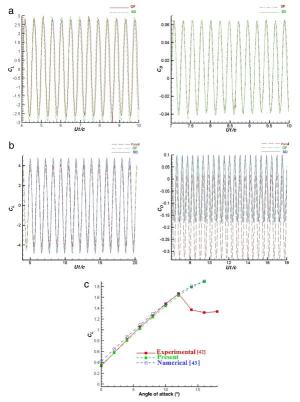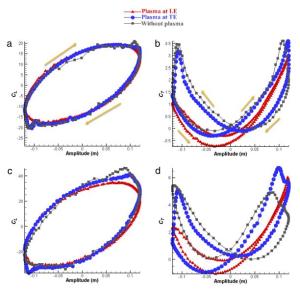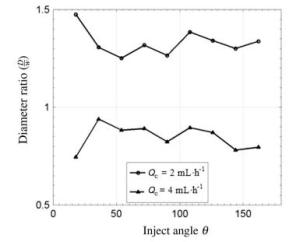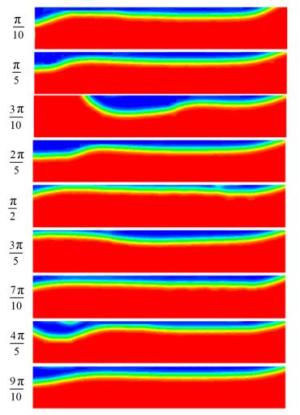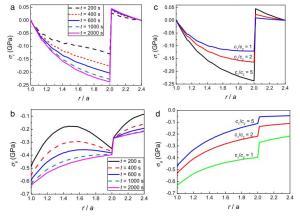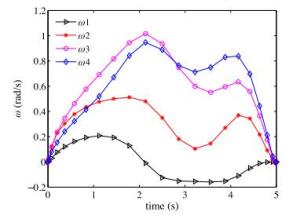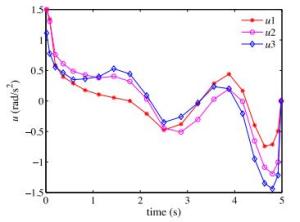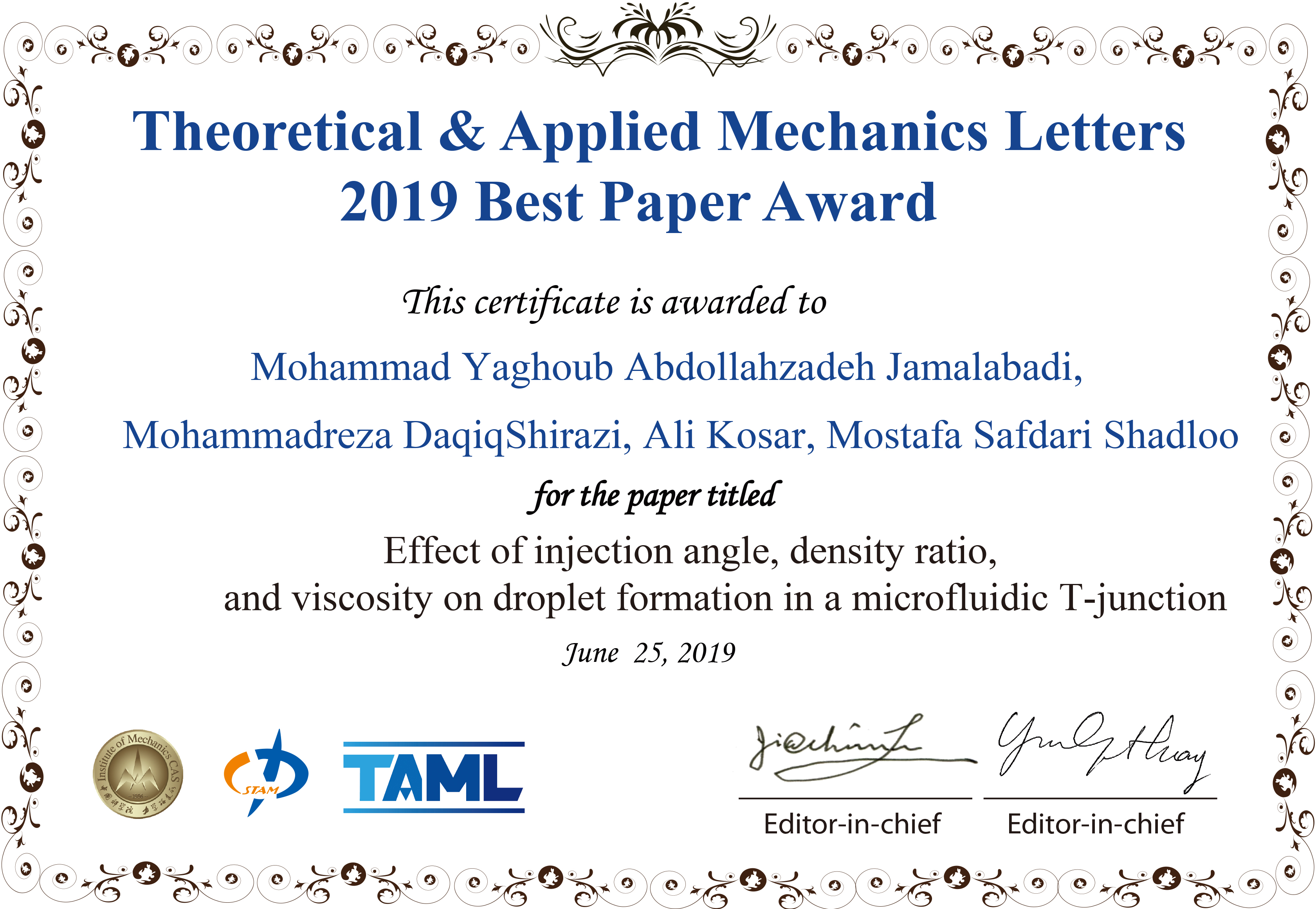Institute of Mechanics,
Chinese Academy of Sciences
2017 Vol.7(4)
Display Mode: |
Theoretical and Applied Mechanics Letters 2017, 7(4): 179-180.
doi: 10.1016/j.taml.2017.09.004
Abstract:
Theoretical and Applied Mechanics Letters 2017, 7(4): 181-184.
doi: 10.1016/j.taml.2017.09.003
Abstract:
Quasi-periodical evolutions such as shedding and collapsing of unsteady cloud cavitating flow, induce strong pressure fluctuations, what may deteriorate maneuvering stability and corrode surfaces of underwater vehicles. This paper analyzed effects on cavitation stability of a trip bar arranged on high-speed underwater projectile. Small scale water tank experiment and large eddy simulation using the open source software OpenFOAM were used, and the results agree well with each other. Results also indicate that trip bar can obstruct downstream re-entrant jet and pressure wave propagation caused by collapse, resulting in a relatively stable sheet cavity between trip bar and shoulder of projectiles.
Quasi-periodical evolutions such as shedding and collapsing of unsteady cloud cavitating flow, induce strong pressure fluctuations, what may deteriorate maneuvering stability and corrode surfaces of underwater vehicles. This paper analyzed effects on cavitation stability of a trip bar arranged on high-speed underwater projectile. Small scale water tank experiment and large eddy simulation using the open source software OpenFOAM were used, and the results agree well with each other. Results also indicate that trip bar can obstruct downstream re-entrant jet and pressure wave propagation caused by collapse, resulting in a relatively stable sheet cavity between trip bar and shoulder of projectiles.
Theoretical and Applied Mechanics Letters 2017, 7(4): 185-198.
doi: 10.1016/j.taml.2017.09.002
Abstract:
In this work, numerical study of two dimensional laminar incompressible flow around an oscillating NACA0012 airfoil is proceeded using the open source code OpenFOAM. Oscillatory motion types including pitching and flapping are considered. Reynolds number for these motions is assumed to be 12000 and effects of these motions and also different unsteady parameters such as amplitude and reduced frequency on aerodynamic coefficients are studied. For flow control on airfoil, dielectric barrier discharge plasma actuator is used in two different positions on airfoil and its effect is compared for the two types of considered oscillating motions. It is observed that in pitching motion, imposing plasma leads to an improvement in aerodynamic coefficients, but it does not have any positive effect on flapping motion. Also, for the amplitudes and frequencies investigated in this paper, the trailing edge plasma had a more desirable effect than other positions.
In this work, numerical study of two dimensional laminar incompressible flow around an oscillating NACA0012 airfoil is proceeded using the open source code OpenFOAM. Oscillatory motion types including pitching and flapping are considered. Reynolds number for these motions is assumed to be 12000 and effects of these motions and also different unsteady parameters such as amplitude and reduced frequency on aerodynamic coefficients are studied. For flow control on airfoil, dielectric barrier discharge plasma actuator is used in two different positions on airfoil and its effect is compared for the two types of considered oscillating motions. It is observed that in pitching motion, imposing plasma leads to an improvement in aerodynamic coefficients, but it does not have any positive effect on flapping motion. Also, for the amplitudes and frequencies investigated in this paper, the trailing edge plasma had a more desirable effect than other positions.
Theoretical and Applied Mechanics Letters 2017, 7(4): 207-221.
doi: 10.1016/j.taml.2017.08.003
Abstract:
To reduce computational costs, an improved form of the frequency domain boundary element method (BEM) is proposed for two-dimensional radiation and propagation acoustic problems in a subsonic uniform flow with arbitrary orientation. The boundary integral equation (BIE) representation solves the two-dimensional convected Helmholtz equation (CHE) and its fundamental solution, which must satisfy a new Sommerfeld radiation condition (SRC) in the physical space. In order to facilitate conventional formulations, the variables of the advanced form are expressed only in terms of the acoustic pressure as well as its normal and tangential derivatives, and their multiplication operators are based on the convected Green's kernel and its modified derivative. The proposed approach significantly reduces the CPU times of classical computational codes for modeling acoustic domains with arbitrary mean flow. It is validated by a comparison with the analytical solutions for the sound radiation problems of monopole, dipole and quadrupole sources in the presence of a subsonic uniform flow with arbitrary orientation.
To reduce computational costs, an improved form of the frequency domain boundary element method (BEM) is proposed for two-dimensional radiation and propagation acoustic problems in a subsonic uniform flow with arbitrary orientation. The boundary integral equation (BIE) representation solves the two-dimensional convected Helmholtz equation (CHE) and its fundamental solution, which must satisfy a new Sommerfeld radiation condition (SRC) in the physical space. In order to facilitate conventional formulations, the variables of the advanced form are expressed only in terms of the acoustic pressure as well as its normal and tangential derivatives, and their multiplication operators are based on the convected Green's kernel and its modified derivative. The proposed approach significantly reduces the CPU times of classical computational codes for modeling acoustic domains with arbitrary mean flow. It is validated by a comparison with the analytical solutions for the sound radiation problems of monopole, dipole and quadrupole sources in the presence of a subsonic uniform flow with arbitrary orientation.
Theoretical and Applied Mechanics Letters 2017, 7(4): 231-234.
doi: 10.1016/j.taml.2017.08.001
Abstract:
The cavitation cloud of different internal structures results in different collapse pressures owing to the interaction among bubbles. The internal structure of cloud cavitation is required to accurately predict collapse pressure. A cavitation model was developed through dimensional analysis and direct numerical simulation of collapse of bubble cluster. Bubble number density was included in proposed model to characterize the internal structure of bubble cloud. Implemented on flows over a projectile, the proposed model predicts a higher collapse pressure compared with Singhal model. Results indicate that the collapse pressure of detached cavitation cloud is affected by bubble number density.
The cavitation cloud of different internal structures results in different collapse pressures owing to the interaction among bubbles. The internal structure of cloud cavitation is required to accurately predict collapse pressure. A cavitation model was developed through dimensional analysis and direct numerical simulation of collapse of bubble cluster. Bubble number density was included in proposed model to characterize the internal structure of bubble cloud. Implemented on flows over a projectile, the proposed model predicts a higher collapse pressure compared with Singhal model. Results indicate that the collapse pressure of detached cavitation cloud is affected by bubble number density.
Theoretical and Applied Mechanics Letters 2017, 7(4): 235-242.
doi: 10.1016/j.taml.2017.06.003
Abstract:
The unsteady mixed convection flow of electrical conducting nanofluid and heat transfer due to a permeable linear stretching sheet with the combined effects of an electric field, magnetic field, thermal radiation, viscous dissipation, and chemical reaction have been investigated. A similarity transformation is used to transform the constitutive equations into a system of nonlinear ordinary differential equations. The resultant system of equations is then solved numerically using implicit finite difference method. The velocity, temperature, concentration, entropy generation, and Bejan number are obtained with the dependence of different emerging parameters examined. It is noticed that the velocity is more sensible with high values of electric field and diminished with a magnetic field. The radiative heat transfer and viscous dissipation enhance the heat conduction in the system. Moreover, the impact of mixed convection parameter and Buoyancy ratio parameter on Bejan number profile has reverse effects. A chemical reaction reduced the nanoparticle concentration for higher values.
The unsteady mixed convection flow of electrical conducting nanofluid and heat transfer due to a permeable linear stretching sheet with the combined effects of an electric field, magnetic field, thermal radiation, viscous dissipation, and chemical reaction have been investigated. A similarity transformation is used to transform the constitutive equations into a system of nonlinear ordinary differential equations. The resultant system of equations is then solved numerically using implicit finite difference method. The velocity, temperature, concentration, entropy generation, and Bejan number are obtained with the dependence of different emerging parameters examined. It is noticed that the velocity is more sensible with high values of electric field and diminished with a magnetic field. The radiative heat transfer and viscous dissipation enhance the heat conduction in the system. Moreover, the impact of mixed convection parameter and Buoyancy ratio parameter on Bejan number profile has reverse effects. A chemical reaction reduced the nanoparticle concentration for higher values.
Theoretical and Applied Mechanics Letters 2017, 7(4): 243-251.
doi: 10.1016/j.taml.2017.06.002
Abstract:
The T-junction microchannel device makes available a sharp edge to form micro-droplets from biomaterial solutions. This article investigates the effects of injection angle, flow rate ratio, density ratio, viscosity ratio, contact angle, and slip length in the process of formation of uniform droplets in microfluidic T-junctions. The governing equations were solved by the commercial software. The results show that contact angle, slip length, and injection angles near the perpendicular and parallel conditions have an increasing effect on the diameter of generated droplets, while flow rate, density and viscosity ratios, and other injection angles had a decreasing effect on the diameter.
The T-junction microchannel device makes available a sharp edge to form micro-droplets from biomaterial solutions. This article investigates the effects of injection angle, flow rate ratio, density ratio, viscosity ratio, contact angle, and slip length in the process of formation of uniform droplets in microfluidic T-junctions. The governing equations were solved by the commercial software. The results show that contact angle, slip length, and injection angles near the perpendicular and parallel conditions have an increasing effect on the diameter of generated droplets, while flow rate, density and viscosity ratios, and other injection angles had a decreasing effect on the diameter.
Theoretical and Applied Mechanics Letters 2017, 7(4): 199-206.
doi: 10.1016/j.taml.2017.09.001
Abstract:
Electrode is a key component to remain durability and safety of lithium-ion (Li-ion) batteries. Li-ion insertion/removal and thermal expansion mismatch may induce high stress in electrode during charging and discharging processes. In this paper, we present a continuum model based on COMSOL Multiphysics software, which involves thermal, chemical and mechanical behaviors of electrodes. The results show that, because of diffusion-induced stress and thermal mismatch, the electrode geometry plays an important role in diffusion kinetics of Li-ions. A higher local compressive stress results in a lower Li-ion concentration and thus a lower capacity when a particle is embedded another, which is in agreement with experimental observations.
Electrode is a key component to remain durability and safety of lithium-ion (Li-ion) batteries. Li-ion insertion/removal and thermal expansion mismatch may induce high stress in electrode during charging and discharging processes. In this paper, we present a continuum model based on COMSOL Multiphysics software, which involves thermal, chemical and mechanical behaviors of electrodes. The results show that, because of diffusion-induced stress and thermal mismatch, the electrode geometry plays an important role in diffusion kinetics of Li-ions. A higher local compressive stress results in a lower Li-ion concentration and thus a lower capacity when a particle is embedded another, which is in agreement with experimental observations.
Low frequency acoustic properties of bilayer membrane acoustic metamaterial with magnetic oscillator
Theoretical and Applied Mechanics Letters 2017, 7(4): 252-257.
doi: 10.1016/j.taml.2017.06.001
Abstract:
A bilayer membrane acoustic metamaterial was proposed to overcome the influence of the mass law on traditional acoustic materials and obtain a lightweight thin-layer structure that can effectively isolate low frequency noise. The finite element analysis (FEA) results agree well with the experimental results. It is proved that the sound transmission losses (STLs) of the proposed structures are higher than those of same surface density acoustic materials. The introduction of the magnetic mass block is different from the traditional design method, in which only a passive mass block is fixed on the membrane. The magnetic force will cause tension in the membrane, increase membrane prestress, and improve overall structural stiffness. The effects of the geometry size on the STLs are discussed in detail. The kind of method presented in this paper can provide a new means for engineering noise control.
A bilayer membrane acoustic metamaterial was proposed to overcome the influence of the mass law on traditional acoustic materials and obtain a lightweight thin-layer structure that can effectively isolate low frequency noise. The finite element analysis (FEA) results agree well with the experimental results. It is proved that the sound transmission losses (STLs) of the proposed structures are higher than those of same surface density acoustic materials. The introduction of the magnetic mass block is different from the traditional design method, in which only a passive mass block is fixed on the membrane. The magnetic force will cause tension in the membrane, increase membrane prestress, and improve overall structural stiffness. The effects of the geometry size on the STLs are discussed in detail. The kind of method presented in this paper can provide a new means for engineering noise control.
Theoretical and Applied Mechanics Letters 2017, 7(4): 222-230.
doi: 10.1016/j.taml.2017.08.002
Abstract:
Rotary pneumatic actuators that are made out of linear one are always best suited for exoskeleton joint actuation due to its inherent power to weight ratio. This work is a modified version of knee actuation system that has already been developed and major modifications are made in order to make it more suitable for human wearing and also to reduce its bulkiness and complexity. The considered actuator system is a rotary actuator where a pulley converts the linear motion of the standard pneumatic piston into the rotary motion. To prove the capability of the actuator, its performance characteristics such as torque and power produced are compared to the required torque and power at the knee joint of the exoskeleton in swing phase and are found to be excellent. The two-way analysis of variance (ANOVA) is performed to find the effect of the throat area valve on knee angle. The ANOVA shows the significant effect of the throat area variation on the knee angle flexion made by the proposed actuator. A relationship between the throat area of flow control valve, that is connected to the exit port of the direction control valve, and angular displacement of the knee joint has been formulated. This relationship can be used to design a control system to regulate the mass flow rate of air at the exit and hence the angular velocity of the knee joint can be controlled.
Rotary pneumatic actuators that are made out of linear one are always best suited for exoskeleton joint actuation due to its inherent power to weight ratio. This work is a modified version of knee actuation system that has already been developed and major modifications are made in order to make it more suitable for human wearing and also to reduce its bulkiness and complexity. The considered actuator system is a rotary actuator where a pulley converts the linear motion of the standard pneumatic piston into the rotary motion. To prove the capability of the actuator, its performance characteristics such as torque and power produced are compared to the required torque and power at the knee joint of the exoskeleton in swing phase and are found to be excellent. The two-way analysis of variance (ANOVA) is performed to find the effect of the throat area valve on knee angle. The ANOVA shows the significant effect of the throat area variation on the knee angle flexion made by the proposed actuator. A relationship between the throat area of flow control valve, that is connected to the exit port of the direction control valve, and angular displacement of the knee joint has been formulated. This relationship can be used to design a control system to regulate the mass flow rate of air at the exit and hence the angular velocity of the knee joint can be controlled.
Theoretical and Applied Mechanics Letters 2017, 7(4): 258-263.
doi: 10.1016/j.taml.2017.05.002
Abstract:
The optimal control of multibody spacecraft during the stretching process of solar arrays is investigated, and a hybrid optimization strategy based on Gauss pseudospectral method (GPM) and direct shooting method (DSM) is presented.First, the elastic deformation of flexible solar arrays was described approximately by the assumed mode method, and a dynamic model was established by the second Lagrangian equation.Then, the nonholonomic motion planning problem is transformed into a nonlinear programming problem by using GPM.By giving fewer LG points, initial values of the state variables and control variables were obtained.A serial optimization framework was adopted to obtain the approximate optimal solution from a feasible solution.Finally, the control variables were discretized at LG points, and the precise optimal control inputs were obtained by DSM.The optimal trajectory of the system can be obtained through numerical integration.Through numerical simulation, the stretching process of solar arrays is stable with no detours, and the control inputs match the various constraints of actual conditions. The results indicate that the method is effective with good robustness.
The optimal control of multibody spacecraft during the stretching process of solar arrays is investigated, and a hybrid optimization strategy based on Gauss pseudospectral method (GPM) and direct shooting method (DSM) is presented.First, the elastic deformation of flexible solar arrays was described approximately by the assumed mode method, and a dynamic model was established by the second Lagrangian equation.Then, the nonholonomic motion planning problem is transformed into a nonlinear programming problem by using GPM.By giving fewer LG points, initial values of the state variables and control variables were obtained.A serial optimization framework was adopted to obtain the approximate optimal solution from a feasible solution.Finally, the control variables were discretized at LG points, and the precise optimal control inputs were obtained by DSM.The optimal trajectory of the system can be obtained through numerical integration.Through numerical simulation, the stretching process of solar arrays is stable with no detours, and the control inputs match the various constraints of actual conditions. The results indicate that the method is effective with good robustness.
 Submit a Paper
Submit a Paper
 Subscription
Subscription
News
MORE+
Call for Papers
MORE+
- Crossing-Mechanics Driven by Big Data
- Machine learning in the fluid mechanics research of wind energy
- Mechanics of Origami/Kirigami structures and metamaterials
- New insights and perspectives on impact biomechanics for human tissues: from injury prevention, protection to protective equipment
- Environmental Mechanics for Extreme Natural Events
















